Assisted Living
What is Assisted Living?
Assisted Living (AL) can generally be described as communities that are licensed by the state to provide a wide range of services, amenities, and personal assistance to residents. They usually house a 24/7 staff that maintains the property and takes care of daily tasks such as cleaning, housekeeping, and preparing meals. Communities promote independence and freedom but they typically employ different types of caregivers that can supervise and assist with daily tasks and non-medical care needs. These include the activities of daily living (ADL’s) such as medication management, assistance with bathing, dressing, and personal hygiene. In-house medical care and rehab services are usually limited in Assisted Living though, on call licensed nurses, doctors, and therapists can come from outside of the community and treat residents. These include visiting Registered Nurses (RN), General Practitioners (GP), Psychologists, and Physical therapists (PT). Assisted Living communities typically have many other great benefits such as social, cultural, recreational activities, and events. There is usually various exercise classes, entertainment, and virtually all communities provide transportation.
Assisted Living is ideal for those who:
- Want a Maintenance reduced or free lifestyle.
- Are finding home management to be more difficult.
- Need assistance with daily tasks (IADL’s) and/or care needs (ADL’s).
- Have been diagnosed with any level of memory impairment (MCI, Dementia, Alzheimer’s).
- Prefer a more affordable option rather than costly home care assistance.
- Wish to live in a more safe and secure environment.
- No longer want to live alone in their home.
- Need to relocate to be closer to family and friends.
- Lack social and recreational opportunities.
- Like to enjoy diverse activities, programs, and classes.
- Need regular transportation for errands and appointments.
What are the main types of Assisted Living?

Independent Living
Ideal for those who no longer want to live alone or who are seeking a maintenance free lifestyle. Complementary services generally include a 24/7 staff or concierge, daily housekeeping, laundry, grocery shopping, meal preparation. Perks consist of furnished rooms, fitness rooms, beauty salons, pools, scheduled events, social engagements, activities, and transportation. Like most Assisted Living Communities they accept respite or short-term and long-term stays.
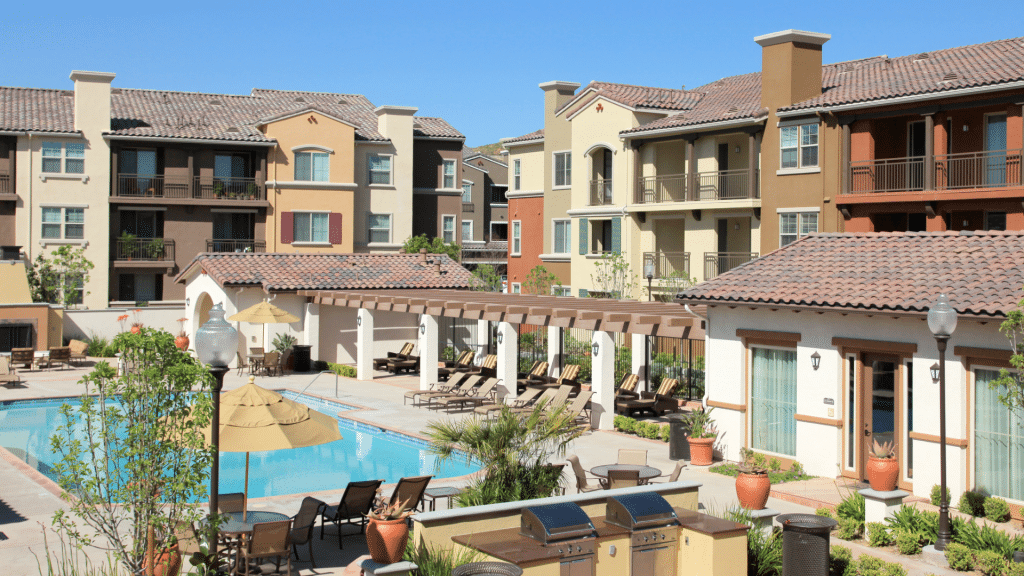
Senior Assisted Living
Consists of an in-house care staff that always includes caregivers and often an onsite physician or licensed nurse. The doctor or nurse can assist with medical needs during the daytime and the caregivers will be able to supervise and provide non-medical assistance 24/7. They can help with medication supervision, dressing, grooming, grocery shopping, preparing meals, using the phone or newspaper, and they can escort to medical appointments. Many times there are wellness programs, scheduled activities and events, diverse in-house amenities such as a library, computer room, exercise room, and outings to the shopping malls and movie theaters.
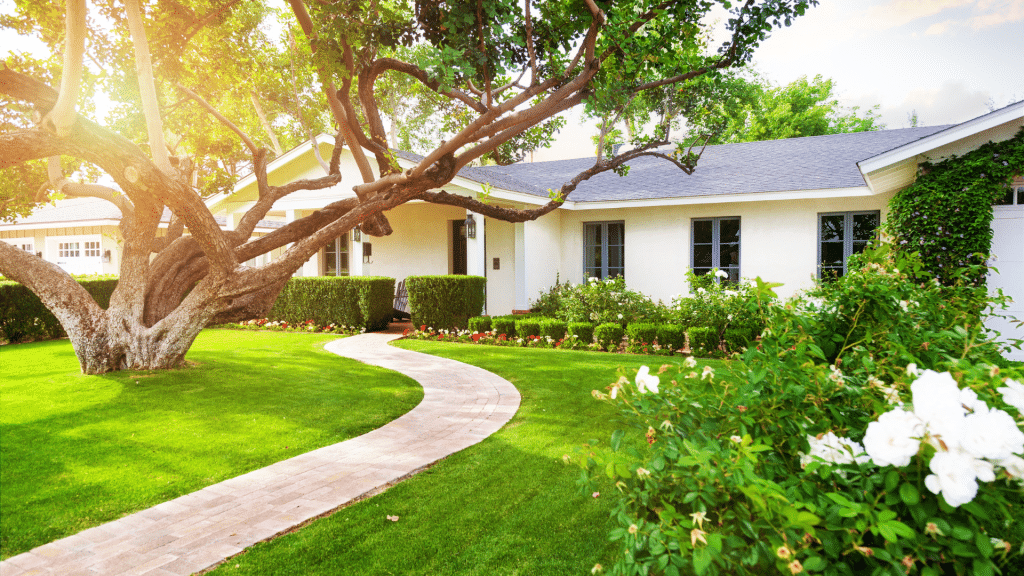
Board and Care
A residential house where you can receive 24/7 assisted care. They are usually licensed for a maximum of 6 residents and have at least two caregivers in the daytime and one at night which is ideal for individuals who require more assistance and attention. They assist with all of the basic activities of daily living (adl’s) such as medication management, dressing, bathing and they can care for people with more intense needs such as assistance with feeding, incontinence care, and two person transfers. They also employ caregiver’s that are specially trained to assist Seniors who have been diagnosed with late-life conditions such as Dementia, Alzheimer’s, and Parkinson’s.
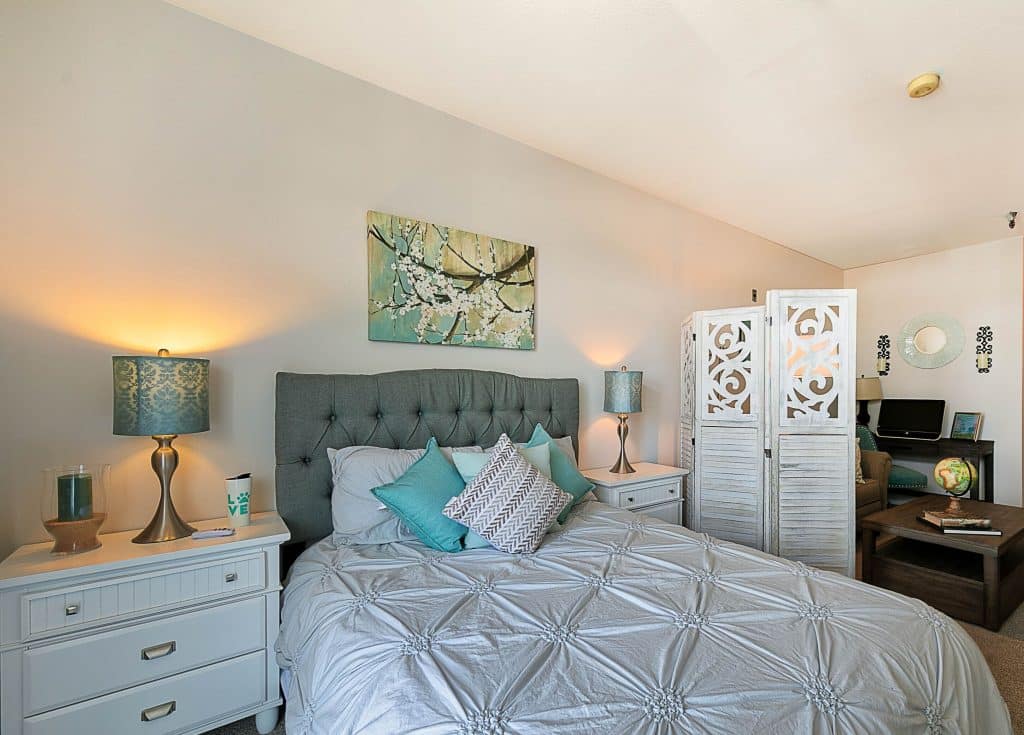
Memory Care
For loved one’s diagnosed with Mild Cognitive Impairment (MCI), Early, mid, later stages of dementia, and Alzheimer’s. Memory Care options have a staff trained to assist and care for them and usually they include such safety measures like controlled access, a wanderguard system, delayed egress doors They even have special care programs designed specifically to help people with the challenges associated with memory impairment.

CCRC (life plan)
Continuing Care Retirement Communities or CCRC (life plan) include independent living, senior assisted living, memory care, and a skilled nursing facility all on the same property. The concept is such that no matter what type of care or level of assistance you will ever need, you will not find yourself in the unfortunate circumstance of having to move to another community. You’ll always be able to receive the wide range of services and assisted care you require all under one roof.
Assisted Living Facilities Comparison Chart

How do I pay for Assisted Living?
Basically all Assisted Living communities accept:
- Private pay (out-of-pocket)
- Long-term care insurance
- Veteran’s Benefits (VA Form 21-2680 -Permanent Need for Regular Aid and Attendance)
Click here to download
Some Assisted Living communities may accept:
- Medi-cal (Medicaid) and other state programs though Medicaid will only pay part of the costs for Assisted Living.
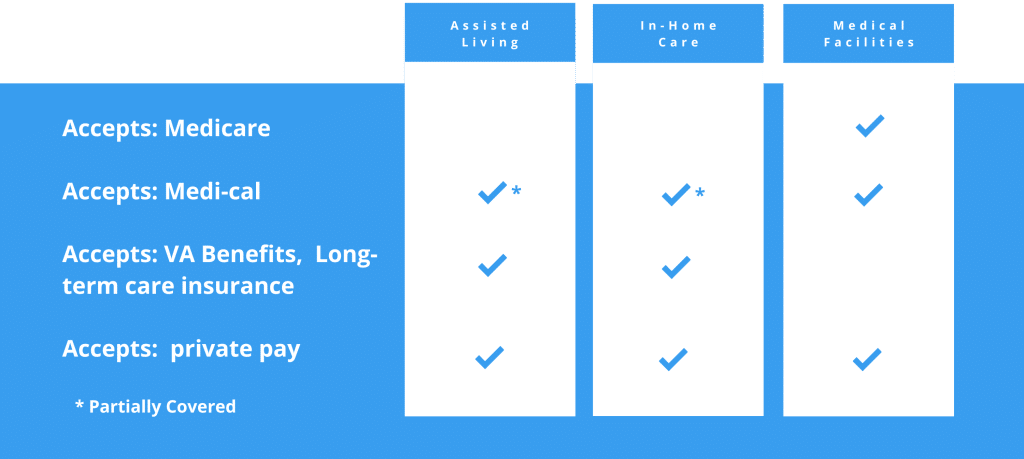
How much should I expect to pay?
The average monthly cost for an AL Community in the United States is approximately $4,500 (all-inclusive cost). This is generally the more affordable and practical option rather than staying at home with a caregiver (about $28 per hour) or remaining in a skilled nursing facility for the long-term. If you stay home and hire a caregiver you will also have to continue paying your mortgage, homeowners insurance, property taxes, utilities, phone bill, cable bill, internet bill, food, and maintenance costs. Additionally, you may need to pay extra costs to make sure your home is safe and secure. This includes medical equipment (shower chair, transfer bench, hospital bed) and home modifications (wheeelchair ramps, lifts, railings, grab bars). If you add up all of those expenses, staying home could definitely cost more. And simply continuing to stay long-term in a skilled nursing facility can cost $350 or more dollars per day which is more than two times and sometimes more than three times as much as the average Assisted Living Community.
The biggest factor in price and how much you will pay in an Assisted Living community is determined by the amount of assistance or how much care you need (level-of-care). You should expect to pay a higher amount if the amount of care you require is higher. Generally these such care needs can make the cost go up: incontinence care, feeding, two-person assist’s or transfers, p.m. assistance (care needed multiple times at night). Other factors that may increase your rate include any additional preferences you may have such as: room size, and luxury amenities such as resort-style living and restaurant-style dining.
Secure Your Personalized and Discounted True Price
Frequently Asked Questions
Though we prefer Assisted Living (AL) communities other terms that may be used include Assisted Living Facility (ALF), Assisted Living Residence (ALR), senior living, senior housing, long-term care facility, retirement living, retirement home, personal care home, residential care home, residential care facility, or in California a Residential Care Facility for the Elderly (RCFE). However, AL is entirely different than a few other names that many people and even many uninformed professionals unfortunately give it. Some common names Assisted Living is often mistaken for include nursing facility, nursing home, or convalescent home.
No. Nursing homes are completely different than Assisted Living. Nursing homes are medical facilities that are technically called Skilled Nursing Facilities (SNF).
Skilled Nursing Facilities (SNF’s) can sometimes be a temporary option to consider for those that are low income, need immediate housing, and are being discharged from the hospital- needing a place to recover after experiencing a major illness or injury. SNF’s offer a hospital like setting that include in-house LVN’s, RN’s, MD’s, PT’s, OT’s, ST’s, and RT’s which is why they are not generally a long-term fit for anyone that does not require a medical need. So, unless you have a tracheostomy, ventilator, gastrostomy tube (g-tube) or some such skilled/ medical need there is really no reason to overstay your welcome. Medicare will usually cover the costs for rehabilitation in a nursing home for about three months (100 days) at the maximum and then Medi-Cal or Medicaid (if you qualify) will sometimes cover the costs once those Medicare days run out. But, long-term stays being covered by Medi-Cal are never a guarantee and they will need to keep re-evaluating your progress or condition in order for you to stay. Paying privately or out-of-pocket at a SNF can be very costly. They typically charge $350 or more dollars per day and this is many times for a shared room with one or more people in the room with you.
After visiting the hospital it’s generally much better for most to simply transition back home for a variety of reasons. Going back home or to a familiar setting can offer many physical, mental, emotional, and even spiritual benefits as opposed to becoming a patient for many weeks or months in a hospital-like nursing facility. Trusted family or friends can help out, assist with day to day chores, errands, and activities of daily living (ADL’s). And if physical, occupational, or speech therapy is needed a loved one could provide the transportation to and from a local rehabilitation center. If trusted family or friends are unable to provide transportation to appointments then you could setup home health care. Home health care companies staff mobile therapists that can drive to your residence and perform the necessary rehab in the comfort of your own home (typically covered 100% by Medicare or private insurance). If loved ones are unable to help out at all then setting up the most appropriate In-Home Care (private 1-on-1 care) would be the next best thing. If In-Home Care is not a safe or realistic option or if the costs are outside of your budget then you may want to consider transitioning to the best fit Assisted Living (AL) Community which could cut your costs in half or even into a third. The average price for an AL Community in the United States is approximately $4,500/ month or about $150/ day and can include a wide range of rooms, activities, events, social engagements, schedule transportation, and diverse amenities to suite everybody’s taste.
Assisted Living communities accept short-term or respite stays (less than 1 month) and long term (months or years).
They generally provide three meals a day plus snacks and beverages
Every community greatly differs from one to the next but generally speaking they provide a 24/7 staff, 3 meals a day, housekeeping, cleaning, laundry, heating and air conditioning, water, electricity, cable, internet, furnished rooms (bed, night stand, dresser or closet), built-in safety and security i.e. wheelchair accessible (ramps/ elevators) Hand Rails, Grab bars ,Door alarm, smoke alarms, locked medication cabinet, transportation to doctor appointments.
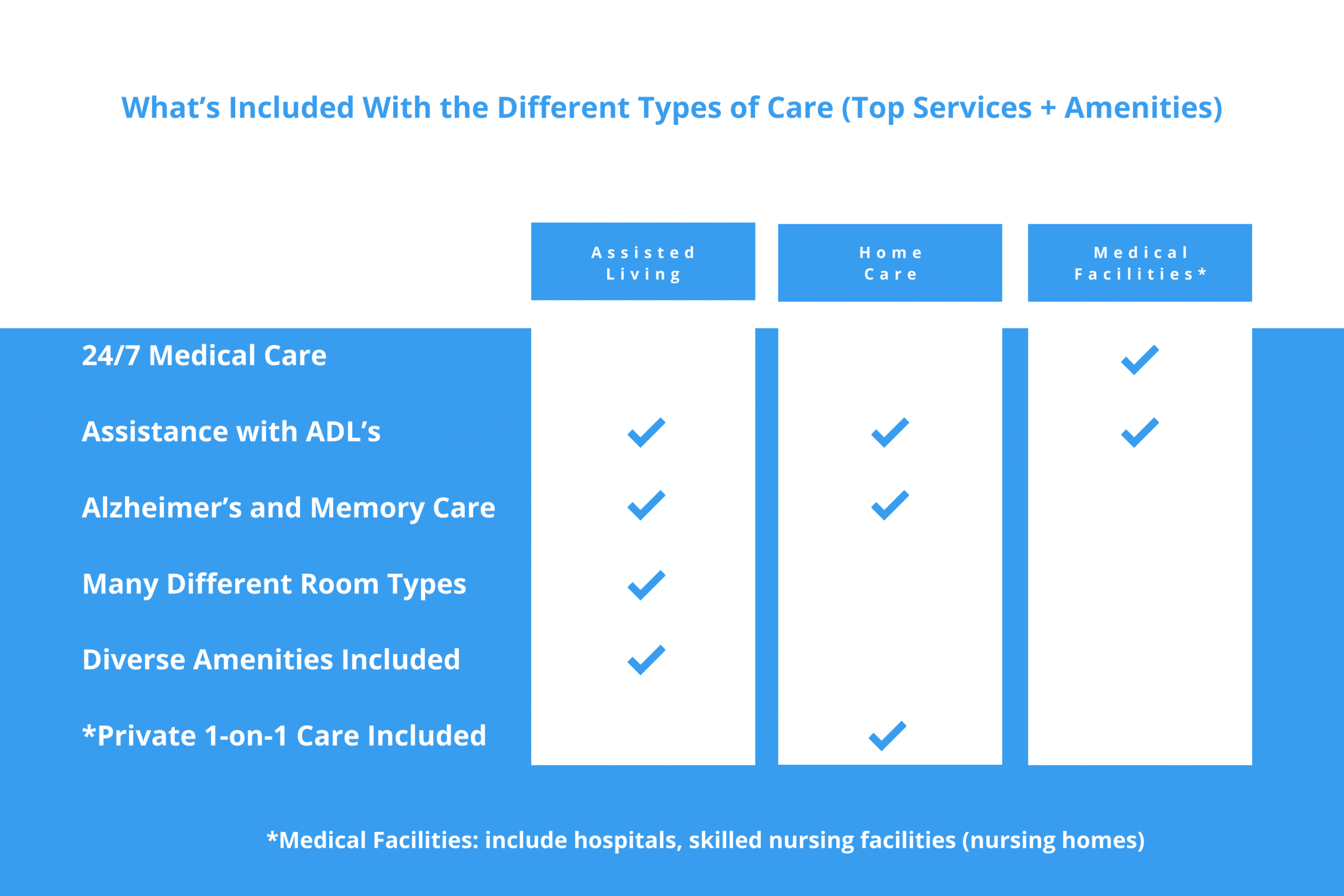
The majority of AL communities have a flexible lease type which is month-to-month and you may choose to leave at anytime for any reason with a thirty day notice. Less common are AL’s that require a long commitment or you to buy-in similar to condominium
Some communities only ask for the 1st month’s rent to move in while others have a community fee, administrative fee, or some such entrance fee. Additional costs can include: care fee’s, additional person fee, incontinence supplies, pet fee.
Absolutely yes. While some incorrectly think that medical facilities like skilled nursing facilities are best for people with memory impairment, the honest truth is that Assisted Living communities would be much more appropriate. The proper type of Assisted Living would be one offering Memory Care (MC) because they offer the very best type of care for those diagnosed with Mild Cognitive Impairment (MCI), early, mid, later stages of dementia, other types of dementia, and Alzheimer’s. Memory care options in Assisted Living can offer a home environment that keeps everything familiar and common, house a staff that is trained to assist and provide the necessary services needed for memory care residents, and many have such safety measures including a secured setting, controlled access, wanderguard system, delayed egress doors, and more. They even have special care programs designed specifically to help people with the challenges associated with memory impairment.
GENERAL Services/ Amenities
- 24/7 staff
- 3 meals a day + snacks
- Housekeeping
- Laundry and linen services
- Cable tv
- internet /wifi
- phone
- emergency call system
- Scheduled activities and Events
- Transportation to medical appt’s
Luxurious General Services/ Amenities
- 24/7 concierge
- In-house licensed physician’s
- In-house licensed nurses
- Daily housekeeping
- Restaurant-style dining
- Room service
- Daily off-site Trips (Shopping, errands)
- Limousine service
- Pet Sitters
- General store
- On-site maintenance
Indoor amenities
- Wellness Center
- Dining Room
- Activity room
- Exercise or Fitness Center
- Beauty or Barber Shop
- Movie or Theatre Room
- Library
- Computer Room
- Lounges
- Game room
- Piano
- Fireplace
Luxurious Indoor Services/ Amenities
- 24 hour Café/ Bistro
- Private dining area
- Salad bar
- In-door pool / spa
- whirlpool tub
- Massage therapy
- Aromatherapy
- Reflexology
- Grand piano
- Saltwater aquarium
- Chapel
- Synagogue
Outdoors services/ amenities
- Scheduled Transportation (Outings to malls, stores, restaurants)
- Landscaped courtyard
- Walk-ways
- Outdoor sitting area
- BBQ
- Fireplace
- Garden
- Pool / spa
- Shuffleboard
- Guest Parking
Luxurious Outdoor services/ amenities
- Daily Chauffeured transportation
- Dry cleaning pick-up
- Covered outdoor Lounge
- Outdoor Flat-screen tv
- Heated spa
- Golf putting green
- Bird Sanctuary
- Reserved Covered Parking Garage
General safety and security equipment
- Controlled access
- Wheelchair accessible
- ramps
- elevators and lifts
- Hand Railings
- Grab bars
- Door alarms
- Smoke/ carbon monoxide detectors
- Sprinkler system
- Fire security system
- Fire extinguisher
- Locked medication cabinet
- Emergency Food and water supply
- First aide kit
Advanced safety and security equipment
- Surveillance video cameras in common areas
- Audible monitors
- Delayed egress system
- Emergency back-up generator
- Walk-in shower or tub
- Hoyer lift
- Hospital bed
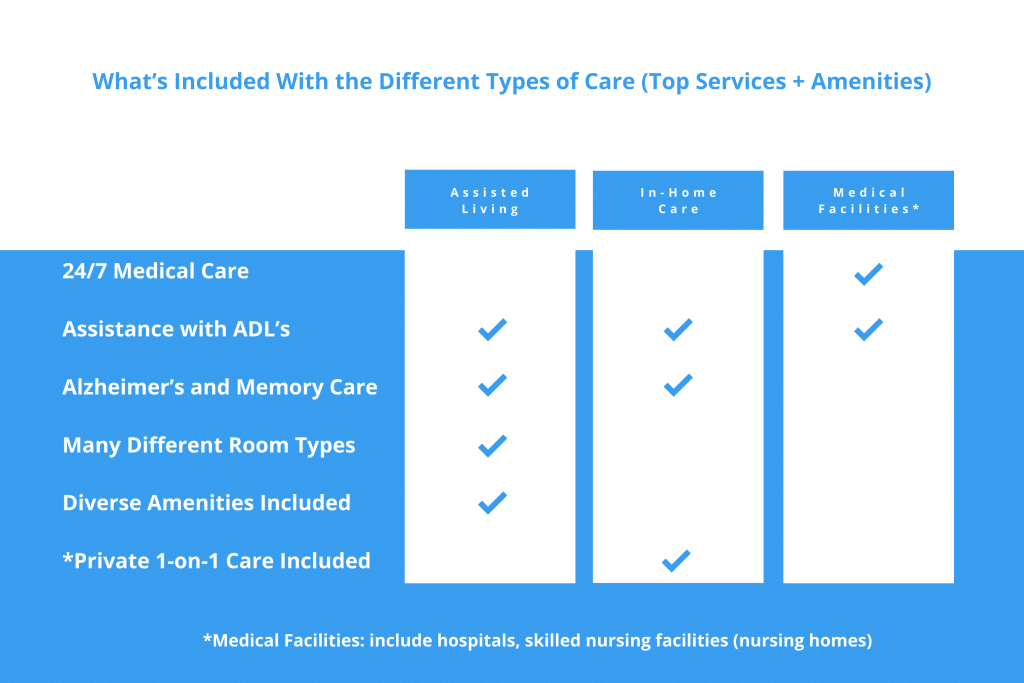
True facts you may not know about Assisted Living communities:
- 7 out of every 8 residents in assisted living are female. Hello gentlemen!
- They are very safe communities to live in because they are licensed through the state, have random inspections, and every staff member is required to have a thorough background check.
- The lease is generally month-to-month with no long-term commitment. So you may leave at anytime for any reason with usually only a 30 day notice.
- There are residential single family homes called Board & Care’s that are licensed Assisted Living Communities. So there might even be a house right next to you that’s an assisted living and you don’t even know it.
- If you are a qualifying Veteran there are programs, non-profit organizations, and even lawyers who specialize in expediating your VA benefits to pay for Assisted Living. Contact us anytime 24/7 for more information.
- Those with memory impairment, dementia, and Alzheimer’s are a great fit for Assisted Living Communities. Unlike nursing homes (skilled nursing facilities) they have beautiful, safe, and secure settings with daily special programs that are specifically designed for people with memory impairment.
Key Terms and Abbreviations
AL = Assisted Living
ALF = Assisted Living Facility
RCFE = Residential Care Facility for the Elderly (technical term for licensed Assisted Living communities in California)
B&C = Board and Care
SAL = Senior Assisted Living
CCRC (life plan) = Continuing Care Retirement Community
SNF = Skilled Nursing Facility or nursing home (commonly mistaken as Assisted Living)
ADL’s = Activities of Daily Living (such as medication management, assistance with bathing, dressing, and personal hygiene)
IADL’s = Instrumental Activities of Daily Living (such as grocery shopping, meal preparation, assistance with the telephone, newspaper, radio, or managing finances)
LTC = Long-Term Care
PCP = Primary Care Physician
GP = General Practitioner
NP = Nurse Practitioner
DON = Director of Nursing Services
RN = Registered Nurse
LPN = Licensed Practical Nurse
DSD = Director of Staff Development
SSD = Social Services Director
LVN = Licensed Vocational Nurse
CHHA = Certified Home Health Aide
CNA = Certified Nursing Assistant
CG = Caregiver
DME = Durable Medical Equipment (such as a wheelchair, shower chair, and fww or front wheel walker)
PT = Physical Therapy
OT = Occupational Therapy
ST = Speech Therapy
RT = Respiratory Therapist
ROM = Range of Motion
CPR = Cardiopulmonary Resuscitation
AED = Automated External Defibrillator
MCI = Mild Cognitive Impairment
DPOA = Durable Power of Attorney
VA = Veterans Affairs
LTCI = Long-Term Care Insurance
CDSS = California Department of Social Services
DHCS = Department of Health Care Services
HMO = Health Maintenance Organization
PPO = Preferred Provider Organization
HIPAA = Health Insurance Portability Accountability Act
